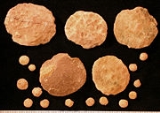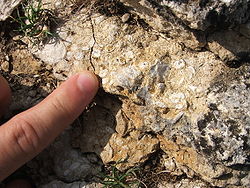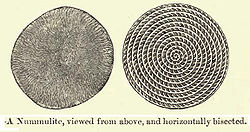
Nummulite
Encyclopedia


Lens (geometry)
In geometry, a lens is a biconvex shape comprising two circular arcs, joined at their endpoints. If the arcs have equal radii, it is called a symmetric lens.A concave-convex shape is called a lune...
fossil
Fossil
Fossils are the preserved remains or traces of animals , plants, and other organisms from the remote past...
, characterized by its numerous coils, subdivided by septa into chambers. They are the shells of the fossil and present-day marine protozoa
Protozoa
Protozoa are a diverse group of single-cells eukaryotic organisms, many of which are motile. Throughout history, protozoa have been defined as single-cell protists with animal-like behavior, e.g., movement...
n Nummulites, a type of foraminifera
Foraminifera
The Foraminifera , or forams for short, are a large group of amoeboid protists which are among the commonest plankton species. They have reticulating pseudopods, fine strands of cytoplasm that branch and merge to form a dynamic net...
n. Nummulites commonly reach 6 cm (2.4 inches) in diameter, and are common in Tertiary
Tertiary
The Tertiary is a deprecated term for a geologic period 65 million to 2.6 million years ago. The Tertiary covered the time span between the superseded Secondary period and the Quaternary...
marine rocks, particularly around the Mediterranean (e.g. Eocene
Eocene
The Eocene Epoch, lasting from about 56 to 34 million years ago , is a major division of the geologic timescale and the second epoch of the Paleogene Period in the Cenozoic Era. The Eocene spans the time from the end of the Palaeocene Epoch to the beginning of the Oligocene Epoch. The start of the...
limestones from Egypt
Egypt
Egypt , officially the Arab Republic of Egypt, Arabic: , is a country mainly in North Africa, with the Sinai Peninsula forming a land bridge in Southwest Asia. Egypt is thus a transcontinental country, and a major power in Africa, the Mediterranean Basin, the Middle East and the Muslim world...
). Fossils up to 6 inches wide are found in the Middle Eocene rocks of Turkey.2 They are valuable as index fossil
Index fossil
Index fossils are fossils used to define and identify geologic periods . They work on the premise that, although different sediments may look different depending on the conditions under which they were laid down, they may include the remains of the same species of fossil...
s.

Latin
Latin is an Italic language originally spoken in Latium and Ancient Rome. It, along with most European languages, is a descendant of the ancient Proto-Indo-European language. Although it is considered a dead language, a number of scholars and members of the Christian clergy speak it fluently, and...
nummulus meaning "little coin", a reference to their shape. In 1913, Randolph Kirkpatrick
Randolph Kirkpatrick
Randolph Kirkpatrick was a British spongiologist, cnidariologist and bryozoologist. He was assistant keeper of lower invertebrates at the British Natural History Museum from 1886 until his retirement in 1927....
published a book, The Nummulosphere: an account of the Organic Origin of so-called Igneous Rocks and Abyssal Red Clays, proposing the theory that all rocks have been constructed by the accumulation of forams such as Nummulites.

